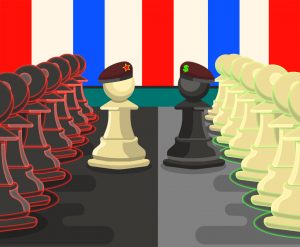 I got my first run in today after two months off. It was refreshing in that I was finally moving beyond the pain, but it also gave me that runner’s high oxygenation that lifts my spirit and fuels my thoughts. My wife and I decided a change of lockdown venue was in order so we relocated to New Mexico (after completing and checking our ballots in Arizona, I will note). My run took me up into the local mountain range and around an iconic rock formation. A coyote was sniffing around the trail until I spooked him. Some things are constant across the West, including the numinous sense of peace and calm that overtook me while I recovered under some trees and watched a few fanned-out contrails slowly drift in the high winds.
I got my first run in today after two months off. It was refreshing in that I was finally moving beyond the pain, but it also gave me that runner’s high oxygenation that lifts my spirit and fuels my thoughts. My wife and I decided a change of lockdown venue was in order so we relocated to New Mexico (after completing and checking our ballots in Arizona, I will note). My run took me up into the local mountain range and around an iconic rock formation. A coyote was sniffing around the trail until I spooked him. Some things are constant across the West, including the numinous sense of peace and calm that overtook me while I recovered under some trees and watched a few fanned-out contrails slowly drift in the high winds.
The fragility of American democracy keeps coming up in the run-up to tomorrow’s elections. Hostility, disinformation, legal actions, disruption, and general uncertainty have overtaken what was once a fairly simple process (Florida in 2000 notwithstanding).
Richard Just wrote a long-form piece in The Washington Post Magazine titled How Religion Can Help Put Our Democracy Back Together, though the title is shockingly more certain than the actual article that rebuilding is possible. Here are some of the ideas that Just circulates:
- If we were all a bit more attuned to the great mysteries that religions promote we would be more humble in our political engagement.
- Perhaps our shift away from religious involvement means that we instead idolatrously attach to political leaders.
- We have become obsessed with politics and lost the sense of inner peace that religions can provide.
- Religious communities are trust building, unlike other kinds of community involvement.





